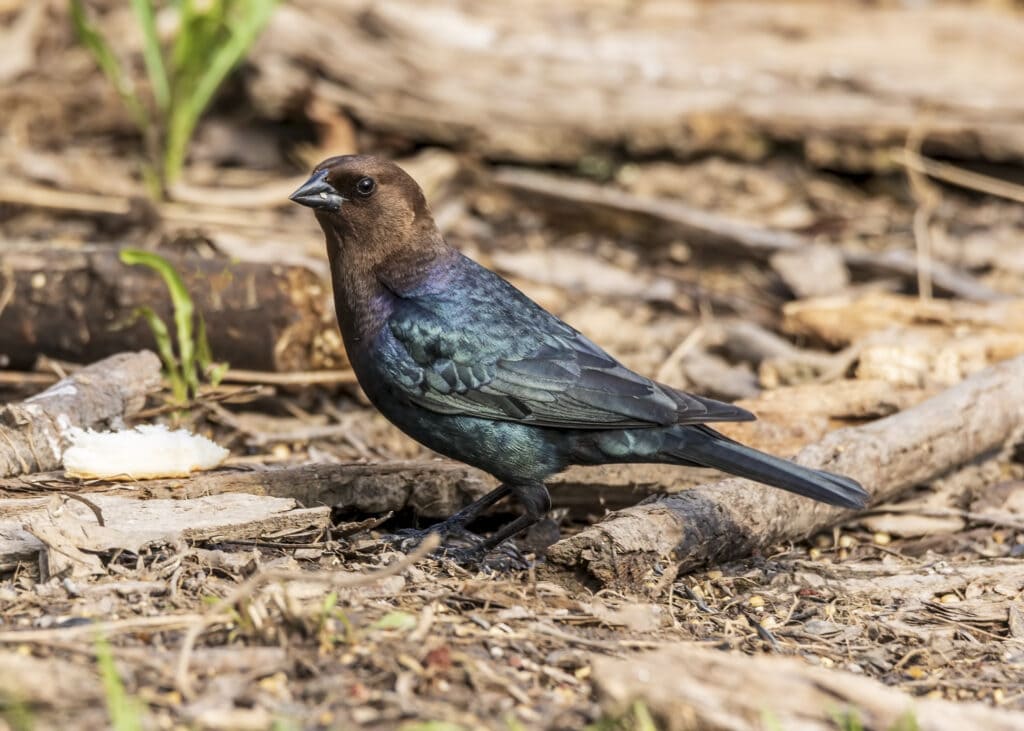Even amongst backyard birds there are beloved heroes and detested villains. It can be difficult to remember that each plays its own role in nature’s balancing act. No bird is responsible for the role it was born into, but that doesn’t make them anymore popular with human onlookers. The Brown-headed Cowbird is the backyard bird that birders love to hate. Plain and brown and stocky, they are unassuming to look at, but it is the Brown-headed Cowbird’s breeding strategy that inspires the backyard birder’s ire. Brown-headed Cowbirds are notorious brood parasites.
Brood parasites are birds that lay their eggs in the nests of other birds. The cuckoo is perhaps the most famous brood parasite, but in North America, this role is occupied by the Brown-headed Cowbird.
Related Article: New Study Examines the Collective Action of Flocking Birds
Fun Facts About the Brown-headed Cowbird
Sneaking eggs into other birds’ nests might seem cruel or unfair, but it’s the only reproduction strategy that Brown-headed Cowbirds have. Before we decide to write this blackbird relative off as a villain, let’s explore some Brown-headed Cowbird fun facts!
Life on the go: Brown-headed Cowbirds aren’t brood parasites because they relish taking advantage of foster parents’ kindness. They lay their eggs in other birds’ nests because it’s the only breeding strategy they have. This is likely because a Brown-headed Cowbird lives life on the go. They’re called “cowbirds” because they’re often seen following herds of cattle. In fact, one alternative name for the Brown-headed Cowbird is the “Buffalo Bird.” It is thought that these birds may have evolved to lay eggs in the nests of other birds because a life of following buffalo around the Great Plains was too transient for them to risk settling down and building a nest of their own.
Sibling rivalry: Some brood parasites deliberately destroy the hosts’ offspring to create more resources for their own babies. The Brown-headed Cowbird does this in a few ways. Mother Brown-headed Cowbirds may destroy an egg when they lay their own to prevent the host bird from noticing a change in the number of eggs in the nest. For the most part, though, the damage done by Brown-headed Cowbirds occurs after hatching. Most of the Brown-headed Cowbird’s hosts are smaller birds that take longer to hatch and grow. In fact, a very young Brown-headed Cowbird chick may be larger than the adult host parents that care for it. So, they consume a lot of resources. The large Brown-headed Cowbird baby is usually bigger, stronger, and more demanding than its foster siblings, giving them a very low chance of survival.
A nesting arms race: Because Brown-headed Cowbirds have such a catastrophic effect on the nests that they target, many birds have developed defense mechanisms to avoid becoming host to these destructive changelings. This has resulted in an evolutionary arms race, with host birds developing defenses and cowbirds developing new ways to sneak past them. Some studies even suggest that Brown-headed Cowbirds engage in “mafia-like” behavior, watching host nests after laying their eggs and destroying the entire nest if their intruder egg is recognized and ejected.
Coming of age cowbird-style: When you’re hatched by a warbler, fed each day by a warbler, and raised by warblers all the way until you’re ready to leave the nest, how do you know how to be a cowbird? It turns out that for Brown-headed Cowbirds, identity is a tricky subject. For one thing, cowbird mothers don’t lay their eggs and then completely ignore their offspring. Though they don’t do the heavy lifting of child-rearing, they do return to host nests to visit their young. What’s more, at about 20 days old, adolescent Brown-headed Cowbirds begin sneaking out of the nest and finding cowbird flocks to roost with. It is thought that this connection to their species is what allows them to grow up without becoming confused and emulating their host species’ behaviors.
The Future of the Brown-headed Cowbird
Brown-headed Cowbirds are abundant, perhaps to a fault, and occasionally need to be culled to allow host species populations to thrive. Though they are widespread and sometimes harmful, their numbers are declining, suggesting that attention should be paid to the habitat health of both Brown-headed Cowbirds and their host species.
Popular Article: Species Spotlight: The Superb Lyrebird

